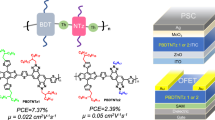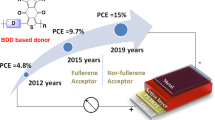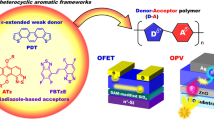Abstract
In this work, we investigated the feasibility of using strongly electron-deficient naphthobispyrazine bisimide (NPI) as a building unit for n-type semiconducting polymers used in organic photovoltaics. We synthesized new n-type semiconducting polymers based on NPI, in which thienothiophene and thiophene were used as counits. The polymers exhibited deep lowest unoccupied molecular orbital energy levels of ~−3.7 eV and narrow optical bandgaps of less than 1.5 eV, which originated from the high electron deficiency of NPI. We found that decreasing the counit length improved the solubilities and reduced the crystallinities of the NPI-based polymers. When blended with the benchmark p-type polymer PTB7-Th, the NPI-based polymers afforded power conversion efficiencies of up to 1.6% and exhibited clear photoresponses at the absorption band of NPI-based polymers. This study shows that NPI-based polymers have good potential as n-type materials for use in organic photovoltaic cells.
This is a preview of subscription content, access via your institution
Access options
Subscribe to this journal
Receive 12 print issues and online access
$259.00 per year
only $21.58 per issue
Buy this article
- Purchase on Springer Link
- Instant access to full article PDF
Prices may be subject to local taxes which are calculated during checkout







Similar content being viewed by others
References
Loo Y-L, McCulloch I. Progress and challenges in commercialization of organic electronics. MRS Bull. 2008;33:653–62.
Lu L, Zheng T, Wu Q, Schneider AM, Zhao D, Yu L. Recent advances in bulk heterojunction polymer solar cells. Chem Rev. 2015;115:12666–731.
Zhao J, Chi Z, Yang Z, Chen X, Arnold MS, Zhang Y, et al. Recent developments of truly stretchable thin film electronic and optoelectronic devices. Nanoscale. 2018;10:5764–92.
Brus VV, Lee J, Luginbuhl BR, Ko S, Bazan GC, Nguyen T. Solution-processed semitransparent organic photovoltaics: from molecular design to device performance. Adv Mater. 2019;31:1900904.
Kim T, Kim J-H, Kang TE, Lee C, Kang H, Shin M, et al. Flexible, highly efficient all-polymer solar cells. Nat Commun. 2015;6:8547.
Lee C, Lee S, Kim G-U, Lee W, Kim BJ. Recent advances, design guidelines, and prospects of all-polymer solar cells. Chem Rev. 2019;119:8028–86.
Wang G, Melkonyan FS, Facchetti A, Marks TJ. All-polymer solar cells: recent progress, challenges, and prospects. Angew Chem Int Ed. 2019;58:4129–42.
Zhang Z, Li Y. Polymerized small-molecule acceptors for high-performance all-polymer solar cells. Angew Chem Int Ed. 2021;60:4422–33.
Jones BA, Facchetti A, Wasielewski MR, Marks TJ. Tuning orbital energetics in arylene diimide semiconductors. materials design for ambient stability of n-type charge transport. J Am Chem Soc. 2007;129:15259–78.
Sun H, Guo X, Facchetti A. High-performance n-type polymer semiconductors: applications, recent development, and challenges. Chemistry. 2020;6:1310–26.
Kang H, Lee W, Oh J, Kim T, Lee C, Kim BJ. From fullerene–polymer to all-polymer solar cells: the importance of molecular packing, orientation, and morphology control. Acc Chem Res. 2016;49:2424–34.
Fratini S, Nikolka M, Salleo A, Schweicher G, Sirringhaus H. Charge transport in high-mobility conjugated polymers and molecular semiconductors. Nat Mater. 2020;19:491–502.
Huang Y, Kramer EJ, Heeger AJ, Bazan GC. Bulk heterojunction solar cells: morphology and performance relationships. Chem Rev. 2014;114:7006–43.
Lee H, Park C, Sin DH, Park JH, Cho K. Recent advances in morphology optimization for organic photovoltaics. Adv Mater. 2018;30:1800453.
Guo X, Facchetti A, Marks TJ. Imide- and amide-functionalized polymer semiconductors. Chem Rev. 2014;114:8943–9021.
Zhou Y, Gu KL, Gu X, Kurosawa T, Yan H, Guo Y, et al. All-polymer solar cells employing non-halogenated solvent and additive. Chem Mater. 2016;28:5037–42.
Guo Y, Li Y, Awartani O, Zhao J, Han H, Ade H, et al. A vinylene-bridged perylenediimide-based polymeric acceptor enabling efficient all-polymer solar cells processed under ambient conditions. Adv Mater. 2016;28:8483–9.
Holcombe TW, Norton JE, Rivnay J, Woo CH, Goris L, Piliego C, et al. Steric control of the donor/acceptor interface: implications in organic photovoltaic charge generation. J Am Chem Soc. 2011;133:12106–14.
Gao L, Zhang Z-G, Xue L, Min J, Zhang J, Wei Z, et al. All-polymer solar cells based on absorption-complementary polymer donor and acceptor with high power conversion efficiency of 8.27%. Adv Mater. 2016;28:1884–90.
Fan B, Ying L, Zhu P, Pan F, Liu F, Chen J, et al. All-polymer solar cells based on a conjugated polymer containing siloxane-functionalized side chains with efficiency over 10%. Adv Mater. 2017;29:1703906.
Saito M, Osaka I, Suda Y, Yoshida H, Takimiya K. Dithienylthienothiophenebisimide, a versatile electron-deficient unit for semiconducting polymers. Adv Mater. 2016;28:6921–5.
Wang Y, Yan Z, Guo H, Uddin MA, Ling S, Zhou X, et al. Effects of bithiophene imide fusion on the device performance of organic thin-film transistors and all-polymer solar cells. Angew Chem Int Ed. 2017;56:15304–8.
Feng K, Guo H, Sun H, Guo X. n-type organic and polymeric semiconductors based on bithiophene imide derivatives. Acc Chem Res. 2021;54:3804–17.
Mikie T, Okamoto K, Iwasaki Y, Koganezawa T, Sumiya M, Okamoto T, et al. Naphthobispyrazine bisimide: a strong acceptor unit for conjugated polymers enabling highly coplanar backbone, short π–π stacking, and high electron transport. Chem Mater. 2022;34:2717–29.
Rivnay J, Toney MF, Zheng Y, Kauvar IV, Chen Z, Wagner V, et al. Unconventional face-on texture and exceptional in-plane order of a high mobility n-type polymer. Adv Mater. 2010;22:4359–63.
Rieger R, Beckmann D, Mavrinskiy A, Kastler M, Müllen K. Backbone curvature in polythiophenes. Chem Mater. 2010;22:5314–8.
Acknowledgements
This work was supported by KAKENHI from JSPS (JP22K14745) and the MIRAI Program from JST (grant no. JPMJMI20E2). This work was partly supported by Next Generation Photovoltaics at Hiroshima University (the Program for Promoting the Enhancement of Research Universities from the Ministry of Education, Culture, Sports, Science and Technology, Japan). 2D-GIXD experiments were performed at BL46XU of SPring-8 with the approval of the Japan Synchrotron Radiation Research Institute (JASRI) (Proposal No. 2019A1765). The authors thank Dr. T. Koganezawa (JASRI) for support in 2D-GIXD measurements.
Author information
Authors and Affiliations
Corresponding authors
Ethics declarations
Conflict of interest
The authors declare no conflict of interest.
Additional information
Publisher’s note Springer Nature remains neutral with regard to jurisdictional claims in published maps and institutional affiliations.
Supplementary information
Rights and permissions
Springer Nature or its licensor (e.g. a society or other partner) holds exclusive rights to this article under a publishing agreement with the author(s) or other rightsholder(s); author self-archiving of the accepted manuscript version of this article is solely governed by the terms of such publishing agreement and applicable law.
About this article
Cite this article
Okamoto, K., Iwasaki, Y., Mikie, T. et al. Naphthobispyrazine bisimide-based semiconducting polymers as electron acceptors for all-polymer photovoltaic cells. Polym J 55, 443–450 (2023). https://doi.org/10.1038/s41428-022-00749-2
Received:
Revised:
Accepted:
Published:
Issue Date:
DOI: https://doi.org/10.1038/s41428-022-00749-2



